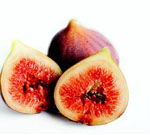|

Beauty Without Cruelty has been asked more than once whether figs contain insects making them non-veg. The answer is yes – and no!
Figs and fig wasps (black insects, 1mm long – there are as many species of fig wasps as there are fig trees, including the related banyan and peepal trees) have been inseparable for millions of years because the wasps are the plant’s sole pollinators.
Figs are actually flowers that grow inwards. The figs from the male trees produce pollen, and the figs from the female trees are the edible ones.
When a female wasp enters a male fig it easily lays eggs. The males that hatch, after impregnating the females, usually die inside or escape with difficulty because they are wingless; but the female wasps that hatch get out easily carrying pollen and continue the cycle of laying eggs.
When a female wasp enters a female fig she gets trapped, is unable to escape, but before she dies from exhaustion, she lays eggs. Therefore, this fig lands up containing at least one dead female wasp. The fig absorbs the dead insect and it becomes a part of the ripened fruit. Without it, the fig will not ripen or be edible. This is why some vegetarians and vegans do not eat figs.
The figs that are commercially grown and sold in India are:
Common or edible figs produced parthenocarpically – that is without the aid of fig wasps or pollination. The varieties of figs that fall under this category are called Poona, Conadria, Mission, Kadota and Brown Turkey.
Capri figs and wild figs are not edible but these male trees are grown for the sole purpose of pollination with fig wasps, without which Smyrna figs can not be produced. The main variety of figs thus produced is called Calimyrna.
Lastly, the first crop of San Pedro figs, known as Breba, is parthenocarpic, but the main or second crop is pollinated by wasps like the Smyrna figs.
Interestingly, figs are not the only trees that are pollinated by wasps. Thousands of other trees like the banyan are also pollinated by different wasps. Each species of the tree has its own species or wasp to pollinate it and no other can do it. Interestingly Jainism forbids the consumption of 5 Udambar fruits which include different types of figs.
Animal pollinators in addition to wasps and bees, include flying insects, butterflies, moths, flies, beetles, ants, birds, bats, small mammals & reptiles (the latter are unusual pollinators).
Incidentally, fungi can be carnivorous too. Certain species of mushrooms like the oyster mushroom, which is primarily a wood decay fungus (white rot) traps nematodes (roundworms) and spiders using droplets of toxin that paralyse and kill them. The creatures are then digested and nutrients and nitrogen absorbed by the mushrooms. (The commonly available dhingri or button mushrooms are not carnivorous fungi.)
|